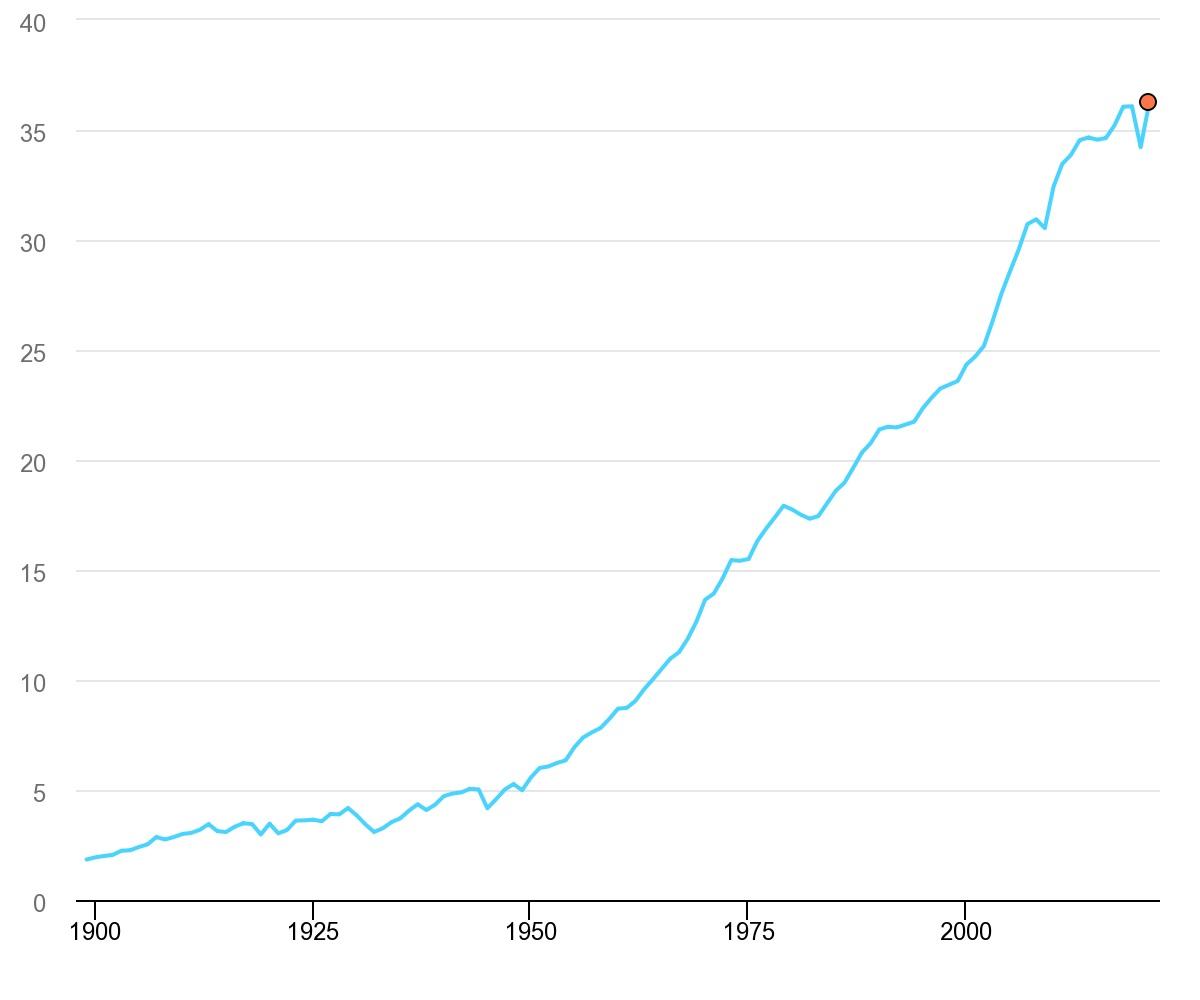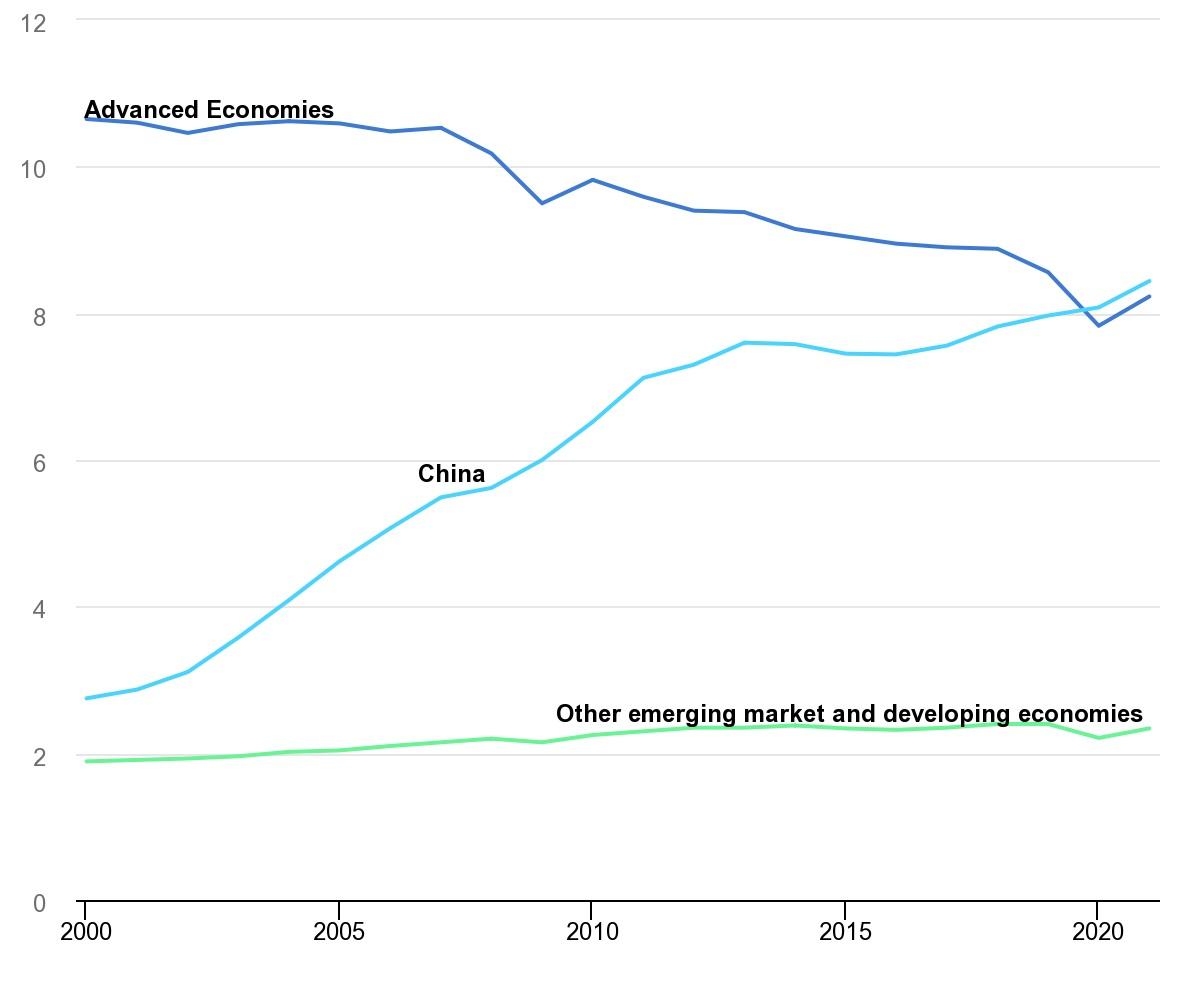Introduction
Carbon gas emissions profoundly impact humanity by causing global climate change. The subsequent extreme weather events, such as wildfires, tropical storms, droughts, and heat waves, disrupt ecology, turning Earth into an inhospitable environment (Osmanski, 2020). The bitter irony of the situation is that humanity, the only force that can reverse the negative trend, acts as its most excellent promoter.
Carbon emissions from global transportation, electricity, heat, and industry heavily impact the environment. For instance, global annual CO2 emissions in 2021 reached 36.3 gigatons, the highest level since 1900 (Figure 1). In this regard, humanity finds itself in a precarious position—the need to reduce the global carbon footprint clashes with the inevitable consequences of economic development. Whereas environmental concerns require steady decarbonization, global economic processes frequently contribute to an increase in harmful emissions.

In general, one can list two fundamental strategies for global carbon footprint reduction. On the one hand, emission avoidance compensates for carbon emissions in other locations (McCormick & Mang, 2021). On the other hand, emission reduction focuses on implementing on-site technological solutions, such as electricity decarbonization, in order to lower the local adverse impact on the environment (Williams et al., 2021). This paper provides an overview of the current global carbon footprint and explores two common approaches to this challenge. In addition, the paper examines potential developments and opportunities associated with the carbon footprint reduction effort.
Global Carbon Footprint: An Overview
The last International Energy Agency’s (IAE) annual report on global carbon footprint offers a comprehensive and rather disappointing picture of the current state of affairs. Most importantly, the global annual CO2 emission from energy combustion and industrial processes increased by 6% from the 2020 level (IAE, 2022). The IAE (2022) associated this carbon emissions surge with the world’s economic recovery from the consequences of the COVID-19 crisis. The 6% increase in emissions was accompanied by the 5,9% growth of the global economic output (IAE, 2022). In this regard, one can claim that the global economy recovered from the pandemic by unsustainable means.
The global increase in CO2 emissions can be primarily associated with the growing demands of the Chinese economy. According to IEA (2022), the economic rebound in China was particularly intensive for the energy sector, as electricity demands grew by 10% in 2021. Consequently, China had to increase its coal consumption by 56% to satisfy the skyrocketing demand for energy (IEA, 2022). The following increase in carbon emissions resulted in China surpassing advanced economies in CO2 emissions per capita. By the end of 2021, the average CO2 emissions in advanced economies have fallen below 8.2 tonnes per capita, whereas Chinese emissions reached 8.4 tonnes per capita on average (Figure 2). Therefore, the Chinese example shows how economic growth creates a push for fossil fuel use, increasing the global carbon footprint.

Overall, the IAE report highlights the correlation between carbon emissions and the high consumption of fossil fuels. In the case of a big country such as China, one can see how electricity production from coal sources can outweigh the decarbonization efforts of the rest of the world. In this regard, it is necessary to list and evaluate the most common carbon footprint reduction strategies. Since economic conditions can hinder global decarbonization in a single major power, one should understand how other countries may prevent the rapid deterioration of the environment.
Common Strategies: Avoidance and Reduction
There are two fundamental approaches to the global carbon footprint reduction process. Firstly, a company or a country may offset a portion of its carbon footprint through avoided emissions. For instance, such initiatives as renewable energy generation or paying a landowner to prevent deforestation can be considered examples of emission avoidance (Naik & Whieldon, n.d.). The emission reduction strategy implies more active involvement in carbon footprint offsetting. For example, a company can reduce emissions directly by capturing CO2 from the atmosphere and storing it in a biomass sink (McCormick & Mang, 2021). Both approaches are associated with specific advantages and limitations, which should be considered before implementation.
Most importantly, carbon emission offsets are useful for building a favorable narrative since certain projects in this category can provide various associated co-benefits. McCormick and Mang (2021) offer an example of giving solar-powered cookstoves to South African women. In this case, the air quality improvement was accompanied by social benefits for women in the region. As a result, the carbon footprint offsetting effort was reinforced with a positive social message. Secondly, the offset initiatives portray decarbonization as a social commodity while the impact of carbon emission on the environment has been undervalued historically (McCormick & Mang, 2021). Lastly, both avoidance and reduction offset strategies can uncover innovative approaches to carbon footprint reduction. For instance, the companies may optimize their business travel patterns, launch special eco-friendly product lines, or organize dedicated events in order to increase public awareness (McCormick & Mang, 2021). Overall, the standard carbon footprint reduction strategies are relatively easy to use, provide co-benefits, and build positive narratives.
However, emission avoidance and reduction are associated with certain limitations, which may decrease their effectiveness. According to Naik and Whieldon (n.d.), the biggest challenge of carbon offsetting stems from the lack of credits generated for counteracting emissions. For instance, capturing CO2 in forests and agricultural soils can offset less than 50% of the annual carbon footprint (Naik & Whieldon, n.d.). In addition, an overzealous attempt to offset carbon emissions may lead to the opposite effect when the public begins viewing offsets as an indulgence for polluting behaviors (McCormick & Mang, 2021). Lastly, implementing the offset strategies requires consistency and long-term dedication, which may become short in supply due to global economic and political complications. Scott and Geden (2018) provide an example of the pressure created by carbon dioxide removal (CDR) on the European Union’s global climate stabilization and green growth paradigm. The CDR goal challenged the seemingly objective EU success story of the 23% carbon emissions reduction over the 1990-2016 period (Scott & Geden, 2018). Therefore, global decarbonization should be based on cooperation and strong leadership. Otherwise, temporary setbacks may instigate disappointment and disrupt the whole process.
Potential Developments and Opportunities
The previous section discussed various advantages and potential limitations of common carbon footprint offsetting strategies. Whereas both strategies may face challenges during the practical implementation, the decarbonization process offers several lucrative opportunities for the national economies. Most importantly, the cumulative effect of technological advancements and policies aimed at offsetting carbon emissions can lead to significant savings. In the case of China, Liu et al. (2022) counted that with the current dynamic, 62% of Chinese electricity could come from non-fossil sources by 2030. As a result, the cost of energy production would be 11% lower compared to the current approach (Liu et al., 2022). Secondly, the nationwide adoption of efficient energy generation would make possible the mitigation of climate change consequences at an affordable price. According to Williams et al. (2021), the cost of achieving zero carbon emissions across the United States would be approximately $1 per day. Finally, the gradual switch to carbon neutrality opens the path for further advancements in various technology areas, such as hydrogen and fusion energy (Liu et al., 2022). In this regard, the push for carbon footprint reduction may serve as a step toward the next industrial revolution.
Given these considerations, one can see how the global carbon footprint reduction opens tremendous opportunities for humanity. However, the opportunities of the new era would be accompanied by certain challenges as major economies of the world would undergo a massive transformation. From the Chinese perspective, Liu et al. (2022) predict profound top-down social and economic reforms, which will create winners and losers on a significant scale. Therefore, one can expect severe challenges for political stability as an aftermath of the global transition to carbon neutrality. Likewise, Williams et al. (2021) recognize the need for careful management of social changes during the major shift in the energy sector. The redirection of $800 billion annually from fossil fuels to carbon-neutral technologies would create strong pressure on the social sector (Williams et al., 2021). As such, vulnerable communities and businesses depending on fossil fuels should receive extra support until a sufficient number of new jobs emerges. In addition, governments and businesses should create strong consumer incentives in order to support global carbon footprint reduction (Williams et al., 2021). Otherwise, the slowness in decarbonization might increase costs and diminish potential gains in terms of carbon footprint reduction.
Conclusion
Last year ended with the all-time highest CO2 emissions from energy combustion and industrial processes as the global economy recovered from the COVID-19 pandemic. The 2021 IEA Global Energy Review allows one to comprehend the world’s interconnectedness — the joint carbon footprint reduction effort was insufficient for offsetting the increased coal consumption of the rebounding Chinese economy. In this regard, one can see that the global carbon footprint reduction would be unachievable without dutiful cooperation from the global powers, such as China and the United States.
Two of the most common offsetting strategies — emission avoidance and emission reduction, provide valuable benefits to corporations and countries. Carbon emission offsets send a favorable social message, imbue carbon footprint reduction with social value, and encourage innovative thinking. However, the lack of credits for counteracting emissions and the absence of strong leadership may reduce the offsets’ effectiveness. In the worst-case scenario, the idea of carbon footprint reduction may be discredited by poor execution.
Nevertheless, carbon footprint reduction is worth the effort since a sound execution of this process would alleviate the climate change threat and create new opportunities for global development. The potential savings in the energy sector could be invested into promising areas, such as hydrogen and fusion energy. In theory, humanity could use the benefits of decarbonization to make a decisive step in the new era of discovery and progress. However, the lucrative opportunities would likely be accompanied by significant challenges for social, economic, and political stability. Therefore, the global carbon footprint reduction would create winners and losers on a large scale and require timely and well-thought-out interventions from the national governments and corporate leaders. Otherwise, the benefits of the new technological revolution might be severely diminished.
References
International Energy Agency. (2022, March). Global Energy Review: CO2 emissions in 2021.
Liu, Z., Deng, Z., He, G., Wang, H., Zhang, X., Lin, J., Qi, Y., & Liang, X. (2022). Challenges and opportunities for carbon neutrality in China. Nature Reviews Earth & Environment, 3(2), 141-155.
McCormick, G., & Mang, A. (2021, December 21). Decarbonization series: The pros and cons of carbon offsets. Inogen Alliance.
Naik, G., & Whieldon, E. (2021). Carbon offsets prove risky business for net-zero targets. S&P Global.
Osmanski, S. (2020). How do carbon emissions affect the environment? Green Matters.
Scott, V., & Geden, O. (2018). The challenge of carbon dioxide removal for EU policy-making. Nature Energy, 3(5), 350-352.
Williams, J. H., Jones, R. A., Haley, B., Kwok, G., Hargreaves, J., Farbes, J., & Torn, M. S. (2021). Carbon‐neutral pathways for the United States. AGU Advances, 2(1), e2020AV000284.